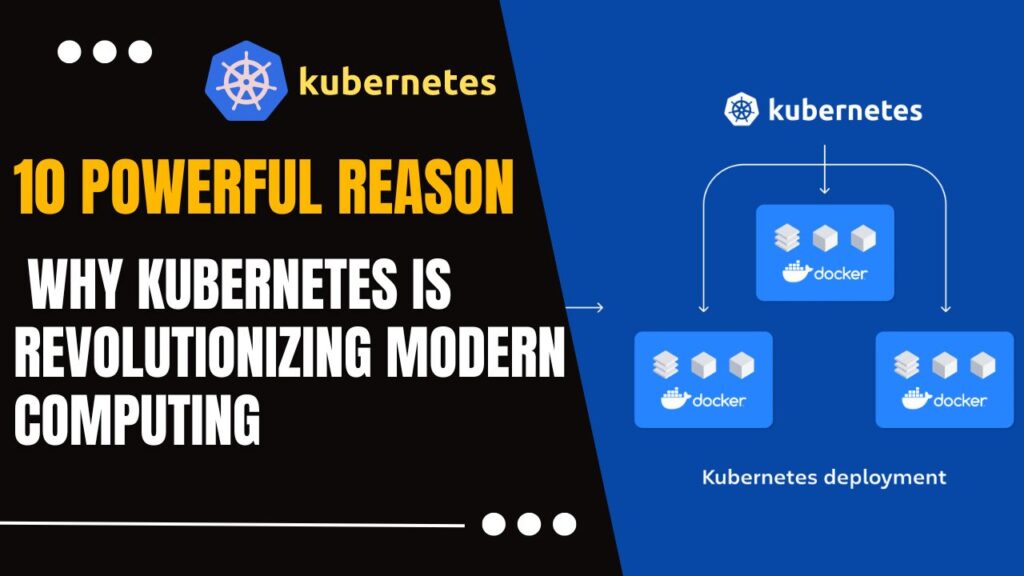
10 Powerful Reasons Why Kubernetes is Revolutionizing Modern Computing
Unveiling the Significance and Impact of Kubernetes in the Digital Era: Introduction:
In the dynamic landscape of modern computing, where scalability, reliability, and efficiency are paramount, Kubernetes emerges as a game-changer. This article delves into the transformative power of Kubernetes, exploring its features, importance, and widespread usage across industries. From its humble origins to its latest versions, Kubernetes has reshaped the way applications are deployed and managed in the cloud-native ecosystem.
- Empowering Scalability with Container Orchestration:
At the heart of Kubernetes lies its ability to orchestrate containers seamlessly. By automating the deployment, scaling, and management of containerized applications, Kubernetes empowers organizations to scale their workloads effortlessly. This scalability ensures that applications can handle varying loads, adapting dynamically to meet demand spikes without compromising performance. - Enhancing Reliability through Self-Healing Mechanisms:
One of Kubernetes’ most notable features is its robust self-healing capabilities. In the event of container failures or node disruptions, Kubernetes automatically detects and replaces unhealthy instances, ensuring continuous availability and minimizing downtime. This inherent resilience makes Kubernetes an ideal platform for mission-critical applications that require high levels of reliability. - Simplifying Application Deployment and Management:
Gone are the days of manual configuration and tedious deployment processes. With Kubernetes, developers can define application resources using declarative YAML manifests, streamlining the deployment and management lifecycle. Whether deploying a single-container application or a complex microservices architecture, Kubernetes abstracts away the underlying infrastructure complexities, allowing teams to focus on innovation and delivery. - Facilitating Microservices Architecture:
In an era dominated by microservices, Kubernetes provides the perfect foundation for building and scaling distributed systems. Its native support for service discovery, load balancing, and dynamic routing enables organizations to embrace microservices architecture with confidence. By breaking monolithic applications into smaller, independent services, Kubernetes fosters agility, scalability, and faster time-to-market for software products. - Enabling Multi-Cloud and Hybrid Cloud Deployments:
With businesses increasingly adopting multi-cloud and hybrid cloud strategies, Kubernetes emerges as the de facto orchestrator for managing diverse infrastructure environments. Whether deploying workloads on public clouds like AWS, Azure, or Google Cloud Platform, or leveraging on-premises data centers, Kubernetes offers a consistent orchestration layer that abstracts away vendor-specific complexities. This portability ensures seamless workload mobility and vendor lock-in avoidance, empowering organizations to leverage the best of both worlds. - Automating Resource Optimization with Horizontal and Vertical Scaling:
Resource optimization is critical in maximizing infrastructure utilization and minimizing costs. Kubernetes provides sophisticated scaling mechanisms, including horizontal and vertical autoscaling, to ensure optimal resource allocation based on application demand. Horizontal scaling adds or removes replicas of pods based on CPU or memory metrics, while vertical scaling adjusts the resource allocation of individual pods dynamically. This automation simplifies capacity planning and optimizes resource utilization, resulting in cost savings and improved efficiency. - Streamlining Continuous Integration and Continuous Deployment (CI/CD):
In the era of DevOps and CI/CD pipelines, Kubernetes seamlessly integrates with popular tools like Jenkins, GitLab CI/CD, and Spinnaker to automate the software delivery process. By leveraging Kubernetes’ native APIs and deployment strategies, organizations can achieve faster feedback loops, automate testing, and deploy changes with confidence. This tight integration between Kubernetes and CI/CD tools accelerates the pace of innovation, enabling teams to deliver value to customers rapidly. - Enhancing Observability with Built-in Monitoring and Logging:
Effective monitoring and logging are essential for maintaining application health and diagnosing issues proactively. Kubernetes offers built-in support for monitoring and logging through tools like Prometheus, Grafana, and Fluentd. By collecting metrics, logs, and events from across the cluster, Kubernetes provides visibility into application performance, resource utilization, and system behavior. This observability enables operators to identify bottlenecks, troubleshoot issues, and optimize performance effectively. - Fostering Community Collaboration and Innovation:
As an open-source project maintained by the Cloud Native Computing Foundation (CNCF), Kubernetes thrives on community collaboration and innovation. With contributions from thousands of developers and organizations worldwide, Kubernetes evolves rapidly, incorporating new features, enhancements, and best practices. This vibrant ecosystem ensures that Kubernetes remains at the forefront of container orchestration technology, driving innovation and pushing the boundaries of what’s possible in modern computing. - Future-proofing Infrastructure with Long-term Support and Compatibility:
In a fast-paced technological landscape, future-proofing infrastructure is paramount. Kubernetes offers long-term support (LTS) releases and backward compatibility guarantees, providing stability and assurance for organizations investing in container orchestration. With predictable release cycles and clear upgrade paths, Kubernetes ensures that enterprises can adopt new features and security updates confidently without disrupting production workloads.
Conclusion:
In conclusion, Kubernetes stands as a testament to the transformative power of open-source innovation in modern computing. From its foundational principles of scalability and reliability to its advanced features for microservices orchestration and multi-cloud deployments, Kubernetes continues to redefine the way applications are built, deployed, and managed in the cloud-native era. By embracing Kubernetes, organizations can unlock new levels of agility, efficiency, and innovation, positioning themselves for success in an increasingly digital world.






